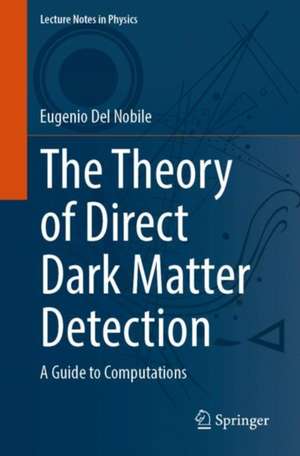The Theory of Direct Dark Matter Detection: A Guide to Computations: Lecture Notes in Physics, cartea 996
Autor Eugenio Del Nobileen Limba Engleză Paperback – 10 mai 2022
Din seria Lecture Notes in Physics
- 19%
 Preț: 423.99 lei
Preț: 423.99 lei - 17%
 Preț: 360.73 lei
Preț: 360.73 lei -
 Preț: 429.22 lei
Preț: 429.22 lei - 17%
 Preț: 427.62 lei
Preț: 427.62 lei - 17%
 Preț: 460.25 lei
Preț: 460.25 lei -
 Preț: 427.96 lei
Preț: 427.96 lei -
 Preț: 481.93 lei
Preț: 481.93 lei - 17%
 Preț: 494.64 lei
Preț: 494.64 lei -
 Preț: 281.90 lei
Preț: 281.90 lei - 17%
 Preț: 493.20 lei
Preț: 493.20 lei - 17%
 Preț: 426.72 lei
Preț: 426.72 lei -
 Preț: 365.15 lei
Preț: 365.15 lei -
 Preț: 374.52 lei
Preț: 374.52 lei -
 Preț: 407.98 lei
Preț: 407.98 lei - 20%
 Preț: 428.12 lei
Preț: 428.12 lei -
 Preț: 263.30 lei
Preț: 263.30 lei - 15%
 Preț: 593.73 lei
Preț: 593.73 lei - 15%
 Preț: 528.13 lei
Preț: 528.13 lei -
 Preț: 493.12 lei
Preț: 493.12 lei - 17%
 Preț: 425.68 lei
Preț: 425.68 lei -
 Preț: 280.65 lei
Preț: 280.65 lei -
 Preț: 163.41 lei
Preț: 163.41 lei - 18%
 Preț: 726.59 lei
Preț: 726.59 lei -
 Preț: 394.84 lei
Preț: 394.84 lei - 15%
 Preț: 709.63 lei
Preț: 709.63 lei - 15%
 Preț: 623.90 lei
Preț: 623.90 lei - 20%
 Preț: 476.91 lei
Preț: 476.91 lei - 15%
 Preț: 428.05 lei
Preț: 428.05 lei -
 Preț: 342.78 lei
Preț: 342.78 lei - 18%
 Preț: 851.93 lei
Preț: 851.93 lei -
 Preț: 346.61 lei
Preț: 346.61 lei -
 Preț: 391.57 lei
Preț: 391.57 lei - 15%
 Preț: 633.16 lei
Preț: 633.16 lei -
 Preț: 451.71 lei
Preț: 451.71 lei - 5%
 Preț: 1497.80 lei
Preț: 1497.80 lei -
 Preț: 374.85 lei
Preț: 374.85 lei -
 Preț: 380.07 lei
Preț: 380.07 lei - 15%
 Preț: 516.14 lei
Preț: 516.14 lei - 15%
 Preț: 583.78 lei
Preț: 583.78 lei - 15%
 Preț: 508.60 lei
Preț: 508.60 lei -
 Preț: 469.71 lei
Preț: 469.71 lei -
 Preț: 388.90 lei
Preț: 388.90 lei - 15%
 Preț: 500.24 lei
Preț: 500.24 lei -
 Preț: 386.52 lei
Preț: 386.52 lei - 15%
 Preț: 472.88 lei
Preț: 472.88 lei -
 Preț: 424.27 lei
Preț: 424.27 lei -
 Preț: 380.07 lei
Preț: 380.07 lei - 15%
 Preț: 500.01 lei
Preț: 500.01 lei
Preț: 469.74 lei
Preț vechi: 552.64 lei
-15% Nou
Puncte Express: 705
Preț estimativ în valută:
89.89€ • 94.16$ • 74.49£
89.89€ • 94.16$ • 74.49£
Carte tipărită la comandă
Livrare economică 08-22 aprilie
Preluare comenzi: 021 569.72.76
Specificații
ISBN-13: 9783030952273
ISBN-10: 3030952274
Pagini: 250
Ilustrații: XVI, 250 p. 20 illus. in color.
Dimensiuni: 155 x 235 x 18 mm
Greutate: 0.38 kg
Ediția:1st ed. 2022
Editura: Springer International Publishing
Colecția Springer
Seria Lecture Notes in Physics
Locul publicării:Cham, Switzerland
ISBN-10: 3030952274
Pagini: 250
Ilustrații: XVI, 250 p. 20 illus. in color.
Dimensiuni: 155 x 235 x 18 mm
Greutate: 0.38 kg
Ediția:1st ed. 2022
Editura: Springer International Publishing
Colecția Springer
Seria Lecture Notes in Physics
Locul publicării:Cham, Switzerland
Cuprins
Introduction.- Rate.- Scattering Kinematics.- From Quarks and Gluons to Nucleons.- DM-Nucleon Interaction.- From Nucleons to Nuclei.- Scattering Cross Section.- DM Velocity Distribution and Velocity Integral.- Phenomenology of Direct DM Detection.- Summary.
Recenzii
“I personally believe this is a very useful read for students, researchers already in the field, or anyone who wants to understand the theoretical framework behind every direct dark-matter-search experiment. I think Del Nobile managed to cover all the necessary ingredients in an extensive and yet not-overwhelming way, and this volume will definitely find its spot on many bookshelves.” (Nikolina Šarčević, The Observatory, Vol. 143 (1294), June, 2023)
Notă biografică
Eugenio Del Nobile received a PhD in Physics in 2012 with a dissertation on some theoretical aspects of particle dark matter models and their direct detection phenomenology. After, he gained postdoctoral positions at UCLA in US, University of Padua in Italy, and University of Nottingham in UK. His research interests are on direct dark matter detection theory and related phenomenology, notably concerning model-independent analyses and methods.
Textul de pe ultima copertă
This book is a pedagogical guide on how to make computations in direct dark matter (DM) detection. The theory behind the calculation of direct detection cross sections and rates is presented, touching aspects related to elementary particle physics, hadronic physics, nuclear physics, and astrophysics. The book is structured in self-contained sections, covering several topics ranging from the scattering kinematics to the phenomenology of direct DM searches. It follows a model-independent approach, aiming at providing the readers with all that is needed to understand the theory and start their own analysis. Meant for graduate students and researchers with interests in particle physics and phenomenology, it is enriched with several worked examples from standard and non-standard particle DM models. Senior researchers working in different areas related to dark matter, like particle and nuclear physics, astrophysics, and cosmology, find in this book a useful and updated guide for reference.
Caracteristici
Explains in details the theory to perform calculations in direct dark matter detection Presents several worked examples to clear the topics An open code in Mathematica invites the reader to hands-on activities to familiarize with the presented concepts
